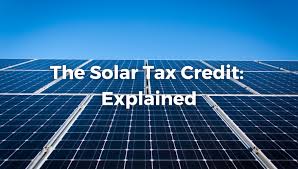Do you want to lower your energy bills and embrace clean energy? Going solar in 2025 has never been more financially appealing, thanks to generous federal tax credits. This guide will walk homeowners and business owners through the process of taking advantage of these valuable incentives by understanding the Solar Investment Tax Credit (ITC) and properly filing Form 5695. With the costs of solar technology continuing to decrease, these tax benefits make renewable energy an accessible and rewarding investment for many. Let’s explore how you can optimize your tax filing to claim the 30% Investment Tax Credit available in 2025!
Understanding the Federal Solar Tax Credit in 2025
The Solar Investment Tax Credit (ITC) offers a significant tax benefit, allowing you to claim 30% of the cost of qualified solar energy systems as a credit against your federal income taxes in 2025. Here are some key points:
- Applicable to Both Residential and Commercial: Whether you’re a homeowner looking to power your house or a business aiming to reduce operating costs, the ITC applies.
- Dollar-for-Dollar Tax Reduction: The credit directly reduces your total tax liability by the amount of the credit.
- No Residential Credit Cap: For homeowners, there is no maximum dollar limit on the 30% credit you can claim on your qualified solar system costs.
- Commercial Credit Over Time: Commercial entities also receive a 30% credit on qualified systems.
- Long-Term Incentive: The 30% tax credit is currently in place through 2032, providing a stable incentive for investing in solar energy. Learn more at EnergySage
Properly claiming this credit can lead to substantial savings on your energy bills over the lifespan of your solar system.
Gathering Required Documentation for Your 2025 Claim
To substantiate your solar project and accurately claim the ITC when you file your 2025 taxes, make sure to collect the following documents:
- Detailed Installation Invoices: These should clearly outline all eligible costs associated with your solar system and provide proof of payments made.
- Certificate of Completion: Obtain this from your solar installer as proof that the system is installed and operational.
- Approved Permits: Secure copies of all necessary permits obtained from your local authority for the solar installation.
- Interconnection Agreement: This document from your utility company confirms that your solar system is properly connected to the grid.
- Depreciation Schedules (for Commercial Systems): If you’re claiming the credit for a commercial system, ensure you have the relevant depreciation schedules.
Organizing these documents before the 2025 tax season will streamline the filing process.
Calculating Your 2025 Credit on Form 5695
To claim the Solar Investment Tax Credit, you’ll need to file Form 5695, Residential Energy Credits (and Nonbusiness Energy Property Credit), with your 2025 federal tax return. Instructions for this form are typically available on the IRS website. Be sure to accurately include the following information:
- System Specifications: Provide details about your solar PV panels, inverters, and any associated labor costs.
- Total Eligible Basis: This is generally 100% of your solar system costs, excluding any rebates you may have received.
- Allowable Credit Rate: For systems placed in service in 2025, this will be 30%.
- Residential Energy Property Credit Amount: Calculate this amount based on the eligible basis and the 30% rate.
- Commercial Energy Credit Amount (if applicable): If you are a business, complete the relevant sections for the commercial credit.
Double-checking your calculations is essential to ensure you don’t miss out on potential savings.
Maximizing Your 2025 Residential Solar Tax Credits
Homeowners can leverage the full amount of the ITC to reduce their tax liability in 2025. Consider these strategies:
- Install Early: Completing your solar installation early in 2025 allows you to claim the full credit when you file your taxes in 2026.
- Consider System Upgrades: If feasible, upgrading your system can increase the total project cost, leading to a larger tax credit and potentially greater energy production.
- Explore Other Incentives: Inquire about other federal, state, or local incentives and rebates that can further reduce the cost of your solar system. Learn about other solar incentives at SolarReviews.
- Credit Rollover: If your tax liability for 2025 is less than the amount of the credit, the excess credit can typically be carried forward to future tax years.
Commercial Solar Tax Credits in 2025
The application of the ITC for commercial solar projects in 2025 has some distinct features:
- 30% of Eligible Basis: Businesses can claim a credit equal to 30% of the cost of their solar system.
- Applied When Costs Are Incurred: The credit can be claimed in the tax year the costs are paid or incurred, even if the system isn’t fully placed in service until a later year.
- No 100% Use Requirement: The credit is applicable even if the solar system doesn’t meet 100% of the building’s energy needs.
This structure allows businesses to benefit from the tax credit throughout the project’s development and boost their cash flow.
Special Considerations for 2025
As you plan your solar project for 2025, keep these points in mind:
- Credit Stability: The residential and commercial ITC is currently set at 30% through 2032, providing long-term certainty for solar investments.
- Confirm System Qualification: Ensure that the solar equipment you choose qualifies for the ITC. Reputable solar installers can help you with this.
- Alternative Minimum Tax (AMT): While less common now, be aware that the Alternative Minimum Tax could potentially limit the amount of the commercial credit you can claim in a given year.
With proper planning, you can confidently maximize the benefits of the solar tax credit in 2025.
READ ALSO: The Complete Guide to Maximizing Tax Credits: Navigating Key Forms Effortlessly
By understanding the Solar Investment Tax Credit and properly filing Form 5695 with your 2025 tax return, both homeowners and business owners can receive a significant tax credit, directly lowering the upfront cost of going solar and reducing their electricity bills for years to come. With the robust 30% credit available in 2025, now is an opportune time to invest in solar energy and contribute to a sustainable future while saving money. Proactive preparation and accurate filing are key to optimizing your solar tax benefits in 2025.






